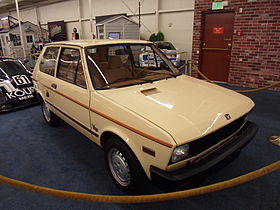Zastava Koral
| Zastava Koral | |
|---|---|
 |
|
| Overview | |
| Manufacturer | Zastava |
| Also called | Yugo Innocenti Koral |
| Production | 2 October 1978–11 November 2008 |
| Assembly | Kragujevac, Serbia |
| Body and chassis | |
| Class | Supermini (B) |
| Body style |
|
| Related | |
| Powertrain | |
| Engine | 0.9-1.3 litre |
| Transmission |
|
| Dimensions | |
| Wheelbase | 2,150 mm (84.6 in) |
| Length | 3,485 mm (137.2 in) |
| Width | 1,548 mm (60.9 in) |
| Height | 1,390 mm (54.7 in) |
| Curb weight | 825 kg (1,819 lb) to 920 kg (2,028 lb) |
The Zastava Koral (pronounced [ˈzâːstaʋa ˈkǒraːl], Serbian Cyrillic: Застава Корал), also known as the Yugo (pronounced [ˈjûɡo]), was a supermini built by the Yugoslav Serbian Zastava corporation. It was designed in Italy under the name Fiat 144 as a variant of the Fiat 127. The first Yugo 45 was handmade on 2 October 1978 as a Fiat 127, under license from Fiat, with a modified body style. The Zastava Koral was sold with an updated design, until 11 November 2008, when production stopped with a final number of 794,428 cars. The Yugo entered the United States by means of Malcolm Bricklin, who wanted to introduce a simple, low-cost car to that market. In total, 141,651 cars were sold in the United States from 1985 to 1992, with the most American units sold in a year peaking at 48,812 in 1987. Sales in 1992 were only 1,412 cars. Like the Lada, they were a common sight in former Yugoslavia in the late 1990s, but the numbers are dying off by present day. Although still a common sight in Serbia, Macedonia and Croatia; in other former Yugoslav countries, like Slovenia, Bosnia & Herzegovina or Montenegro, where the Yugo actually never achieved much popularity, it is a rare sight.
In the lifetime of the model range the car has gone under a variety of different names:
...
Wikipedia
